Bratislava, currently the capital of Slovakia and the country's largest city, has existed for about a thousand years. Because of the city's strategic geographical location, it was an important European hub due to its proximity to the advanced cultures of the Mediterranean and the Orient as well as its link to the rest of Europe, which were possible by the Danube River.

Lajos Kossuth de Udvard et Kossuthfalva was a Hungarian nobleman, lawyer, journalist, politician, statesman and governor-president of the Kingdom of Hungary during the revolution of 1848–1849.

The Austro-Hungarian Compromise of 1867 established the dual monarchy of Austria-Hungary, which was a military and diplomatic alliance of two sovereign states. The Compromise only partially re-established the former pre-1848 sovereignty and status of the Kingdom of Hungary, being separate from, and no longer subject to, the Austrian Empire. The compromise put an end to the 18-year-long military dictatorship and absolutist rule over Hungary which Emperor Franz Joseph had instituted after the Hungarian Revolution of 1848. The territorial integrity of the Kingdom of Hungary was restored. The agreement also restored the old historic constitution of the Kingdom of Hungary.
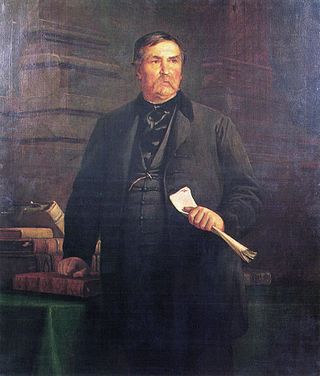
Ferenc Deák de Kehida was a Hungarian statesman and Minister of Justice. He was known as "The Wise Man of the Nation" and one of the greatest figures of Hungary's liberal movement.

Count István Széchenyi de Sárvár-Felsővidék was a Hungarian politician, political theorist, and writer. Widely considered one of the greatest statesmen in his nation's history, within Hungary he is still known to many as "the Greatest Hungarian".
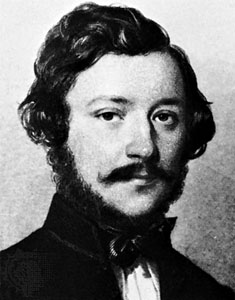
József baron Eötvös de Vásárosnamény was a Hungarian writer and statesman, the son of Ignác baron Eötvös de Vásárosnamény and Anna von Lilien, who stemmed from an Erbsälzer family of Werl in Germany. Eötvös name is sometimes anglicised as Joseph von Eotvos.

The Hungarian Academy of Sciences is the most important and prestigious learned society of Hungary. Its seat is at the bank of the Danube in Budapest, between Széchenyi rakpart and Akadémia utca. Its main responsibilities are the cultivation of science, dissemination of scientific findings, supporting research and development, and representing Hungarian science domestically and around the world.
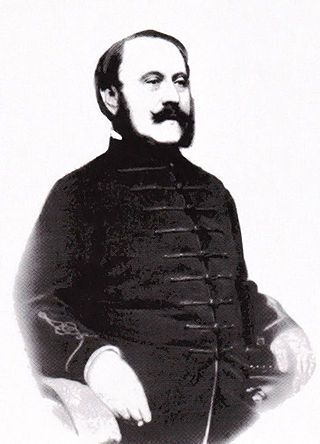
Baron Zsigmond Kemény was a writer from the Austrian Empire.
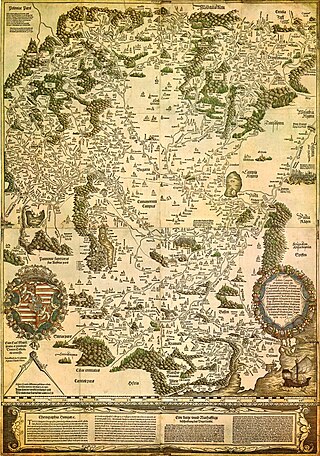
The Kingdom of Hungary held a noble class of individuals, most of whom owned landed property, from the 11th century until the mid-20th century. Initially, a diverse body of people were described as noblemen, but from the late 12th century only high-ranking royal officials were regarded as noble. Most aristocrats claimed ancestry from chieftains of the period preceding the establishment of the kingdom around 1000; others were descended from western European knights who settled in Hungary. The lower-ranking castle warriors also held landed property and served in the royal army. From the 1170s, most privileged laymen called themselves royal servants to emphasize their direct connection to the monarchs. The Golden Bull of 1222 established their liberties, especially tax exemption and the limitation of military obligations. From the 1220s, royal servants were associated with the nobility and the highest-ranking officials were known as barons of the realm. Only those who owned allods – lands free of obligations – were regarded as true noblemen, but other privileged groups of landowners, known as conditional nobles, also existed.
Unio Trium Nationum was a pact of mutual aid codified in 1438 by three Estates of Transylvania: the nobility, the Saxon (German) patrician class, and the free military Székelys. The union was directed against the whole of the peasantry, regardless of ethnicity, in response to the Transylvanian peasant revolt.

The Kingdom of Hungary between 1526 and 1867 existed as a state outside the Holy Roman Empire, but part of the lands of the Habsburg monarchy that became the Austrian Empire in 1804. After the Battle of Mohács in 1526, the country was ruled by two crowned kings. Initially, the exact territory under Habsburg rule was disputed because both rulers claimed the whole kingdom. This unsettled period lasted until 1570 when John Sigismund Zápolya abdicated as King of Hungary in Emperor Maximilian II's favor.
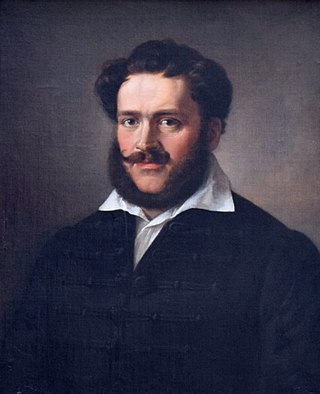
Baron Miklós Wesselényi de Hadad was a Hungarian statesman, leader of the upper house of the Diet, member of the Board of Academy of Sciences, hero of the 1838 Pest flood. A prominent and wealthy Hungarian aristocrat, son of Baron Miklós Wesselényi and Ilona Cserei, he was born at Zsibó, and was educated at his father's castle by Mózes Pataky in a liberal and patriotic direction. He inherited his father's physical strength, and he further trained himself in different sports, such as horse-riding and swimming. He was a celebrity in his age for his sportsman's accomplishments.
The Early Modern Times in Romania started after the death of Michael the Brave, who ruled in a personal union, Wallachia, Transylvania, and Moldavia – three principalities in the lands that now form Romania – for three months, in 1600. The three principalities were subjected to the Ottoman Empire, and paid a yearly tribute to the Ottoman Sultans, but they preserved their internal autonomy. In contrast, Dobruja and the Banat were fully incorporated into the Ottoman Empire.

Janko Drašković was a Croatian politician who is associated with the beginnings of the Illyrian movement, a 19th-century national revival. Drašković studied law and philosophy before joining the military, from which he was discharged on medical grounds. In the 1790s, Drašković pursued a political career, winning a seat in the Croatian Parliament and in the Diet of Hungary.

The Hungarian Revolution of 1848, also known in Hungary as Hungarian Revolution and War of Independence of 1848–1849 was one of many European Revolutions of 1848 and was closely linked to other revolutions of 1848 in the Habsburg areas. Although the revolution failed, it is one of the most significant events in Hungary's modern history, forming the cornerstone of modern Hungarian national identity—the anniversary of the Revolution's outbreak, 15 March, is one of Hungary's three national holidays.

The history of the Székely people can be documented from the 12th century. According to medieval chronicles, the Székelys were descended from the Huns who settled in the Carpathian Basin in the 5th century. This theory was refuted by modern scholars, but no consensus view about the origin of the Székelys exists. They fought in the vanguard of the Hungarian army, implying that they had been a separate ethnic group, but their tongue does not show any trace of a language shift.
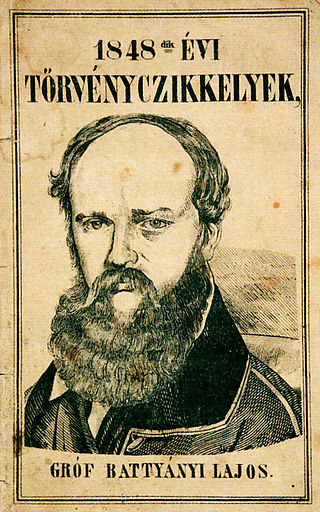
The April Laws, also called March Laws, were a collection of laws legislated by Lajos Kossuth with the aim of modernizing the Kingdom of Hungary into a parliamentary democracy, nation state. The laws were passed by the Hungarian Diet in March 1848 in Pozsony and signed by king Ferdinand V at the Primate's Palace in the same city on 11 April 1848.

The Diet of Hungary or originally: Parlamentum Publicum / Parlamentum Generale was the most important political assembly in Hungary since the 12th century, which emerged to the position of the supreme legislative institution in the Kingdom of Hungary from the 1290s, and in its successor states, Royal Hungary and the Habsburg kingdom of Hungary throughout the early modern period until the end of World War II. It was mainly held in big cities, traditionally in Pozsony, one of the most important Hungarian cities. The name of the legislative body was originally "Parlamentum" during the Middle Ages, the "Diet" expression gained mostly in the early modern period. It convened at regular intervals with interruptions from the 12th century to 1918, and again until 1946.

Miksa Falk was a Hungarian politician, journalist, member of the Hungarian Academy of Sciences and the editor-in-chief of the German-language newspaper Pester Lloyd.

The Slovak Uprising , Slovak Volunteer Campaigns or Slovak Revolt was an uprising of Slovaks in Western parts of Upper Hungary with the aim of equalizing Slovaks, democratizing political life and achieving social justice within the 1848–49 revolutions in the Habsburg Monarchy. It lasted from September 1848 to November 1849. In October 1848, Slovak leaders replaced their original Hungaro-federal program by Austro-federal, called for the separation of a Slovak district from the Kingdom of Hungary and for the formation of a new autonomous district within the framework of the Habsburg Monarchy.
















